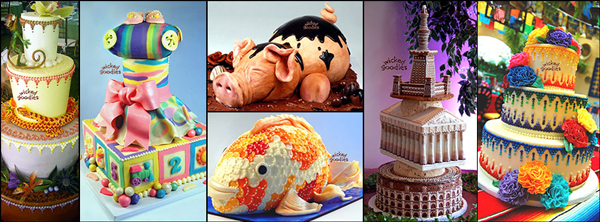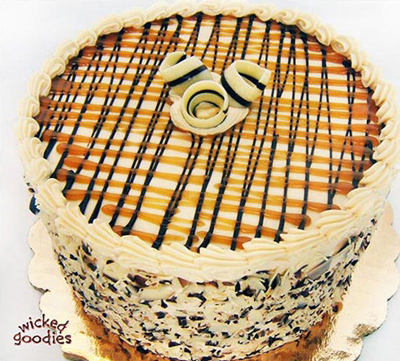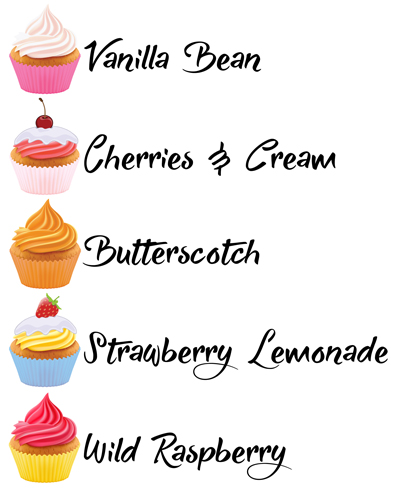This is Part 5 from 125 Building Blocks for Your Bakery Business

Once you have your bakery brand identity and logo established, it’s time to customize your website. If you have been following the steps of this book in order, then earlier on, when you created your brand, you already picked out your domain name and tag line needed herein.
Claim Your Domain
It may be tempting to grab a free domain on blogging and web platforms such as blogspot. However there’s a catch. It’s not and never will be your domain. It’s their domain. You’re just borrowing space on it.
Domains are reasonably priced for the most part so there is no logical reason not to buy one. Moreover, there are many advantages to owning your own from the beginning.
Advantages to Owning Your Own Web Domain
When you own your domain, you can do anything you want with it. You have total control. As your business grows, you will accumulate a web presence and a kind of rapport with the search engines that is yours to keep. For those reasons, I don’t recommend parking your website on someone else’s domain (example: WickedGoodies.blogspot.com).
Hiring Website Designers vs. DIY
When it comes to picking a design platform, you may be tempted to hire someone. Keep in mind that web designers are not cheap and they tend to use custom code, which creates a dependency on your part to hire them back for updates. Over time, that will add up cost-wise.
You are much better off learning how to run your own site by yourself. The truth is that there are some excellent template-based website platforms out there that are free and relatively easy to operate. My preferred platform is WordPress. Be warned that template-based platforms like WordPress and Blogger do not offer customer support (they are free, after all) but they do have user-generated discussion forums with helpful info where you can find the answers to most questions.
For a bakery business, being able to make updates on your own website is vital when it comes to announcing specials, modifying menus, rewriting product descriptions and changing pricing. Using WordPress, you can do all those things without having to learn code.
Ideally you should be able to modify at least the content fields of your website by yourself. If not, hopefully you have a spouse or close friend who can do this for you. The person must be readily available however. All too often, I consult with bakery owners who originally asked a relative or friend to do them the favor of building a website for free. Now the site is incomplete or outdated because the designer never got around to finishing or making updates. The problem is that designer did the baker a favor to begin with, so now the baker feels indebted and uncomfortable asking for more help.
One workaround when it comes to asking for favors or paying a professional designer is to barter with an amateur webmaster (e.g. trade cakes in exchange for website updates). That way, there is some incentive for them to get the work done regularly.
Pay Attention to SEO
The World Wide Web is an enormous database where being found by your target market is a matter of how much work you put into SEO (search engine optimization), which is the act of embedding descriptive data on your site to help search engines find and index your material. It also involves networking with similar websites in order to create inbound links. The easiest way to receive inbound links from a fellow bakers is to make them yourself by commenting on their site using your web address.
If you don’t implement SEO, search engines will have more trouble interpreting your website. If you do practice SEO, as long as you conduct your website ethically, search engines will send a steady and increasing stream of potential customers your way.
Google is the most-used search engine so it helps to make use of all the services they have to offer. Get Google Analytics so that you can track your traffic flow and see how your visitors are engaging with your site, and follow Google’s SEO Guide. Here in the U.S., second to Google is Yahoo, which is often used for local business searches, so make sure to get listed there too. Climbing search engine rankings takes time and effort but will happen if you implement SEO.
Write Meta Descriptions
Every website needs a meta description for each page. The meta description is a brief summary, no more than 150 characters long, which most accurately describes the content of that page. This is especially important for the home page or landing page on your site, which search engines recognize as the defining face of your brand. The meta description for your home page should be a longer version of your tagline. It’s what customers will see in the search following the business name itself. If you do not enter a description then search engines will assign one by grabbing whatever text comes first on your home page. This text is not necessarily going to be useful or appropriate as a description, so I highly recommend entering this data yourself.
My home page description is: Cake designs, baking ideas, gingerbread houses, recipes, and tutorials for hobbyists & bakery professionals to learn the business of selling desserts.
|
Notice how many keywords I crammed into that? My brand, Wicked Goodies, contains zero keywords so I am reliant on my description to do all the work.
Develop Keyword Rich Content

It is vitally important to make sure that you are using correctly spelled key words on your website, especially on the home page. The home page will be the most crawled and visited page on your site so it should contain as much metadata as possible.
Think about it like this: What are your potential customers typing into Google when they go looking for products like yours in your area? Those are the word combinations that you should be using the most on every page of your site, especially on the home page.
Common Keywords Used by Bakeries
- Cake
- Bakery
- Baker
- Birthday Cake
- Wedding Cake
- Desserts
Website Building Exercise
- Make a list of the top 20 search terms that relate to your business.
- Are these words embedded in your website in as many places as possible?
- If not, plug them in to your text and description.
- Make sure they appear on the home page.
Create Social Media Links

I recommend including prominent links to your social media accounts in the sidebar of your website so they are visible on every single page that your customers navigate. I also recommend including them in the footer of your email so when you interact with customers via email, they have a chance to follow you. Don’t miss these opportunities to capture a connection with your customer base. The openings are fleeting but each one amounts to the difference between establishing an ongoing relationship with that customer or potentially never connecting with them again.
Display Your Location Prominently

Make sure your location is listed prominently on your website. Do not assume that the Internet knows what state you are in. Search engines need to be told. Plus customers should be able to confirm your exact whereabouts. For all bakeries, I recommend adding your address and phone number somewhere up around the header, in a fixed location on your website that remains on every page.
If you work from home and therefore don’t want to leave a home address online, that’s okay but it’s still important to leave a city, town, region, state, country, and zip code. Add the phrase By appointment Only in a large, noticeable font to indicate that drop-ins aren’t welcome. Then, if you do choose to list your home address, be prepared for the occasional customer to show up at your door. Many potential customers use Yelp or their mobile phones to search for bakeries and don’t notice when the listing is not associated with a retail establishment. Those folks are likely to head your way. I am not even a bakery and I still get calls from time to time from people who are in their cars, driving around looking for me.
Add Your Telephone Number

You absolutely should list a phone number on your site so customers can reach you when they have questions. I don’t recommend listing your personal cell phone number for a couple of reasons. First, putting your number on the internet means it will land on call lists, which leads to annoying solicitous calls. You also don’t want customers having your personal number because that crosses the necessary divide you need to maintain (for sanity) between your work and personal life.
Add a Contact Page

Even if you have your address and phone number listed in a static location around your header or sidebar, it’s still good to have a contact page. The contact page should repeat all of your contact information once again but it typically has some more helpful bits.
Contact Page Add-Ons
- An embedded map, so customers can easily search for directions to your shop
- Your hours of operation
- Your name
- Your email address
- Your social media links
- A contact form
- Helpful links to information designed to help the customer do business with you more efficiently
On your contact page, I also recommend listing the towns, cities, and counties that you are willing to service besides your own. That will help customers find you when they type in the word “bakery” plus the name of their town of residence. Fortunately, search engines are smart enough to assume that you probably also service surrounding areas. However it will help your rankings in the listings for those surrounding areas if you include the names of those places yourself.
Embed a Contact Form
In addition to the basic contact page on your website, I recommend adding an order inquiry form for customers who are seeking estimates on orders. This will save you some time by guiding the customer to provide all the information you need to process a quote. If you run a custom cake business, here are the types of fields you want to include on your contact form.
- Name
- Date of Event
- Time of Event
- Pickup or Delivery Required?
- Delivery location
- Number of Servings Needed
- Nature of the Event (wedding, birthday, etc.)
- Party Theme, if any
- Allergy Concerns
With this much information, you can determine right away if it’s a viable order or not.
Add an About Page

A photo of your smiling face plus your full name should be included on your website’s About page. If you don’t want to use a photo of yourself, use a photo of your bakery storefront. If you don’t want to use your real full name, use a pen name. Keep in mind that it is rather impersonal to withhold both a name and a face. It may raise suspicion around the legitimacy of your business, since legitimate businesses tend to freely list this type of information.
Display Your Photo Portfolio

Always take photos of your work—the good, the bad, and the ugly—because you never know when you might need to reference that experience again. However, when it comes to your web portfolio, only include your best work. Choose photos that demonstrate your range of skills: some square cakes, some round cakes, some stacked cakes, some wedding cakes, some with fondant, some with buttercream, etc. As your collection of photos grows, prune it down, getting rid of the less attractive cakes. If you’ve executed the same or similar cake twice, only chose to include the best one.
Note: One photo per cake is all that’s necessary in a bakery portfolio. Find the best glamour shot—the one that looks good both up close and as a thumbnail—and let that be it. I repeat, only one photo per cake. Anything more is redundant.
Do not include photos of trademarked character cakes anywhere on your website or social media. This is a legal no-no. To learn more about this topic, watch my video, A Baker’s Guide to Trademark and Copyright Law
Add Watermarks & Metadata

I highly recommend watermarking your photos before publishing them on the Internet so that anyone can trace the work back to its origin. PicMonkey.com is a free photo editing site that allows you to position text on a photo just like a watermark.
Also make sure that the photo’s metadata (file name and info) is descriptive and accurate with your business name included.
Display Your Product List

On your website, include as much information as possible with regards to your product list. This will make it easier for potential customers to research your business before making a call. This will also supply you with quick and easy sales tools to reference no matter where you are when you field a call. The chapter on Product Design contains a handy tool for writing winning product descriptions.
Include Pricing Info
Whenever possible, include pricing information on your website so customers can pre-determine if their budget falls within your range. Especially when it comes to sculpted cakes and wedding cakes, making your pricing structure available will cut down on the amount of questions you have to field.
Example: Standard Square Multi-Tiered Cake Pricing
$4.00/serving for shortening-based or whipped cream finish
$4.50/serving for real buttercream finish
$5.00/serving for chocolate glaze or ganache finish
$5.50/ serving for basic fondant finish
$6.00/serving for modeling chocolate or fancy fondant finish
I have much more information on this topic here: Wedding Cake Pricing Guide
Compile an Email List

No matter what kind of business you run, it behooves you to embed a subscribe button into your site as a way to collect an email list of contacts. With an email list, you can send out news regarding holiday specials, promotions, and events at your store. Loyal customers will enjoy hearing from you. This is an excellent way to build brand loyalty.
Add a Call to Action Button

Encourage your customers to place an order by including a call to action button in the sidebar of your website that says HOW TO ORDER or ORDER A CAKE NOW! Make sure the button is available on every page of your site. If possible, route your call to action button to your inquiry form on your site that asks everything you need to know up front in order to quote a price.
Website Building Checklist
- Buy your domain outright (I recommend doing this through GoDaddy)
- Purchase a basic hosting package
- Install a user-friendly interface such as WordPress
- Read Google’s SEO Guide
- Enter meta descriptions on all pages, beginning with the home page
- Display your phone number and address prominently on every page
- Display your social media buttons on every page
- Enter keyword rich content
- Add an About page
- Add a Contact page
- Embed a Contact form
- Add a Photo Portfolio
- Watermark your photos
- Add a Pricing page
- Add an email signup
- Add a Call to Action button
- Install Google Analytics on your site
- Monitor your analytics data and metrics
- Study your visitor behavior and demographics
- Make improvements on your site as needed
This is the end of Part 5 from 125 Building Blocks for Your Bakery Business. Return to the Table of Contents or proceed to Part 6 – Bakery Product Design

Related Material





